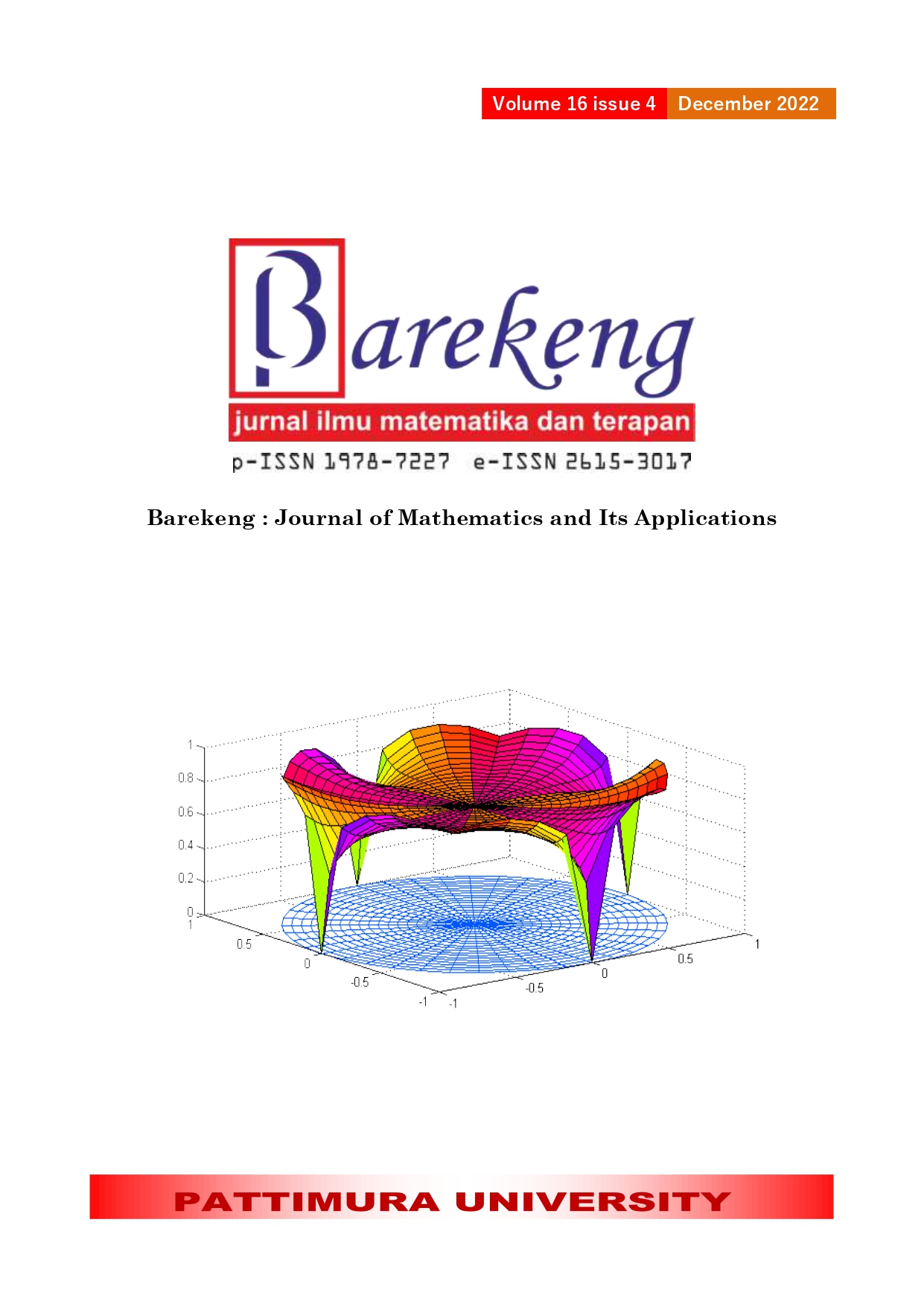ANALYSIS OF OPTIMUM CONTROL ON THE IMPLEMENTATION OF VACCINATION AND QUARANTINE ON THE SPREAD OF COVID-19
Abstract
This study constructs an SVIR-type COVID-19 spread model into a model with control variables or optimum control problems. In the formulation of the model with controls, we set four control variables, namely vaccination strategy, quarantine, reduction of vaccine shrinkage, and treatment. Pontryagin 's maximum principle is applied in the model as a sufficient condition to achieve optimum conditions for minimizing the objective function . This study uses a numerical solution to describe the theoretical results. The results showed that the control model could accelerate the decrease in the number of individuals in the infected population class. We found that vaccination is a top priority that needs to be done to reduce the number of cases of COVID-19 infection. In addition, the implementation of quarantine can also be considered to accelerate the decrease in the number of individuals infected with COVID-19.
Downloads
References
Z. Ding et al. , “Association of liver abnormalities with in-hospital mortality in patients with COVID-19,” J. Hepatol. , pp. 1–8, 2020, doi:10.1016/j.jhep.2020.12.012.
Ministry of Health of the Republic of Indonesia, “Ministry of Health of the Republic of Indonesia,” 2020, [Online]. Available: https://covid19.kemkes.go.id/qna-questions-and-answer-terkait-covid-19/.
FS Taccone et al. , “The role of organizational characteristics on the outcome of COVID-19 patients admitted to the ICU in Belgium,” Lancet Reg. heal. - Euros. , vol. 000, no. 2020, p. 100019, 2020, doi:10.1016/j.lanepe.2020.100019.
M. Abdy, S. Side, S. Annas, W. Nur, and W. Sanusi, "A SIR epidemic model for COVID-19 spread with fuzzy parameters: the case of Indonesia," Adv. Differs. Equations, vol. 2021, no. 1, 2021, doi:10.1186/s13662-021-03263-6.
S. Annas, MI Pratama, M. Rifandi, W. Sanusi, and S. Side, “Stability analysis and numerical simulation of SEIR model for the COVID-19 pandemic spread in Indonesia,” Chaos, Solitons and Fractals, vol. 139, p. 110072, 2020, doi:10.1016/j.chaos.2020.110072.
TM Chen, J. Rui, QP Wang, ZY Zhao, JA Cui, and L. Yin, “A mathematical model for simulating the phase-based transmissibility of a novel coronavirus,” Infect. Dec. Poverty, vol. 9, no. 1, pp. 1–8, 2020, doi:10.1186/s40249-020-00640-3.
D. Okuonghae and A. Omame, “Analysis of a mathematical model for COVID-19 population dynamics in Lagos, Nigeria,” Chaos, Solitons and Fractals, vol. 139, p. 110032, 2020, doi:10.1016/j.chaos.2020.110032.
R. Resmawan, AR Nuha, and L. Yahya, “Dynamic Analysis of COVID-19 Transmission Models Involving Quarantine Interventions,” Jambura J. Math. , vol. 3, no. 1, pp. 66–79, 2021, doi:10.34312/jjom.v3i1.8699.
AR Nuha, N. Achmad, and N. 'Ain Supu, “Analysis of the Mathematical Model of the Spread of Covid-19 With Vaccination and Treatment Interventions,” J. Mat. UNAND , vol. 10, no. 3, p. 406, 2021, doi:10.25077/jmu.10.3.406-422.2021.
Marwan, “The Role of Vaccines in Handling the COVID19 Pandemic,” LPPM Univ. Mulawarman, 2020.
W. Choi and E. Shim, “Optimum strategies for social distancing and testing to control COVID-19,” J. Theor. Biol. , vol. 512, p. 110568, 2021, doi: 10.1016/j.jtbi.2020.110568.
A. Olivares and E. Staffetti, “Optimum control-based vaccination and testing strategies for COVID-19,” Comput. Methods Programs Biomed. , vol. 211, p. 106411, 2021, doi:10.1016/j.cmpb.2021.106411.
M. Zamir, T. Abdeljawad, F. Nadeem, A. Wahid, and A. Yousef, “An optimum control analysis of a COVID-19 model,” Alexandria Eng. J. , vol. 60, no. 3, pp. 2875–2884, 2021, doi:10.1016/j.aej.2021.01.022.
S. Seddighi Chaharborj, S. Seddighi Chaharborj, J. Hassanzadeh Asl, and PS Phang, “Controlling of the COVID-19 pandemic using optimum control theory,” Results Phys. , vol. 26, no. May, p. 104311, 2021, doi:10.1016/j.rinp.2021.104311.
AI Abioye et al. , “Mathematical model of COVID-19 in Nigeria with optimum control,” Results Phys. , vol. 28, no. July, p. 104598, 2021, doi:10.1016/j.rinp.2021.104598.
Z. Armandani and Y. Fuad, “Application of the SEIQR Model with Optimum Control in the Dynamic System of the COVID-19 Pandemic,” J. Ilm. Matt. , vol. 7, no. 2, pp. 67–71, 2019.
O. Agossou, MN Atchadé, and AM Djibril, “Modeling the effects of preventive measures and vaccination on the COVID-19 spread in Benin Republic with optimum control,” Results Phys. , vol. 31, 2021, doi:10.1016/j.rinp.2021.104969.
ZH Shen, YM Chu, MA Khan, S. Muhammad, OA Al-Hartomy, and M. Higazy, “Mathematical modeling and optimum control of the COVID-19 dynamics,” Results Phys. , vol. 31, p. 105028, 2021, doi:10.1016/j.rinp.2021.105028.
AC Chiang, Elements of Dynamic Optimization. London: McGraw-Hill Education, 1992.
N. . P. TU, Dynamical Systems: An Introduction with Applications in Economics and Biology 2nd ed. Springer-Verlag, 1994.
Central Bureau of Statistics, "Total Birth Rate by Province 2012-2017," 2017. https://www.bps.go.id/indicator/30/1399/1/ bird-rate-total-according-province.html.
Copyright (c) 2022 Agusyarif Rezka Nuha, Novianita Achmad, Gusti Arviana Rahman, Syarif Abdullah, Sri Istiyarti Uswatun Chasanah, Nina Valentika, La Ode Nashar

This work is licensed under a Creative Commons Attribution-ShareAlike 4.0 International License.
Authors who publish with this Journal agree to the following terms:
- Author retain copyright and grant the journal right of first publication with the work simultaneously licensed under a creative commons attribution license that allow others to share the work within an acknowledgement of the work’s authorship and initial publication of this journal.
- Authors are able to enter into separate, additional contractual arrangement for the non-exclusive distribution of the journal’s published version of the work (e.g. acknowledgement of its initial publication in this journal).
- Authors are permitted and encouraged to post their work online (e.g. in institutional repositories or on their websites) prior to and during the submission process, as it can lead to productive exchanges, as well as earlier and greater citation of published works.






1.gif)



